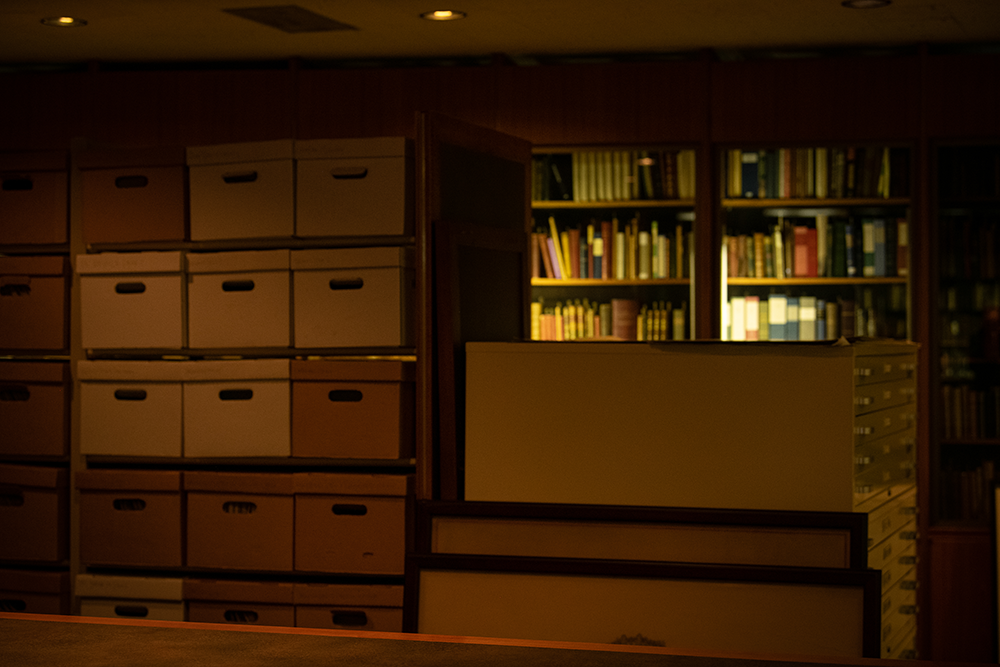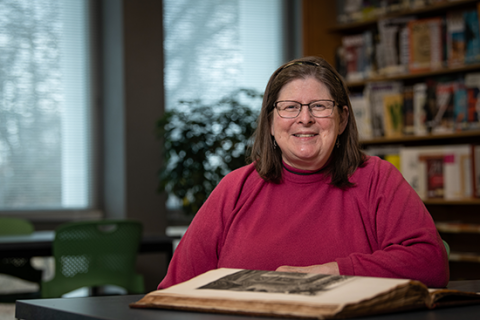
Mary Kay Johnsen's career as the Special Collections Librarian at the University Libraries began September 15, 1982. Before it comes to an end this summer, with Johnsen's retirement after 38 years of service, we sat down to capture some of her favorite memories.
How did you get started in this field?
I spent my teen years in the DC suburbs, taking the bus to the museums and libraries. I wasn't allowed to go to the shopping mall but I could go to the Smithsonian on the National Mall. In college, when I needed to declare majors, a little voice said, 'What do you want to do? What will get you up on a cold morning when it's 12 degrees.' The answer was, I want to keep and share cultural artifacts—and that has been a theme throughout my career.
 What's your educational background and how did you come to work at CMU?
What's your educational background and how did you come to work at CMU?
I have a master's degree in library science from Catholic University Library School, a masters in art history from the University of Pittsburgh and a master's of public management from Heinz. I spent a year at a National Endowment for the Arts-funded internship at the Toledo Museum of Art to learn how to teach in museums. After that, I considered a PhD but I got a job working in special collections at George Washington University as a paraprofessional and stayed there for 6 years. I did everything the librarians did—exhibits, cataloguing, and working with students. I helped our Architecture librarian Martin Aurand, with a reference question when he was at GW studying urban policy. A few years later, when he walked in to Hunt Library on his first day on the job we recognized each other right away! In 1982, I interviewed in July with then-director Tom Michalak at the American Library Association conference and started in September.
When you think back to your early years on the job, what memories stand out?
On my first day, I was welcomed by an assistant. The then-director Anne Skoog was out of the office, so from my very first day, I was the special collections librarian. I'm doing the same for Sam Lemley, the new curator of special collections. Even though we will overlap for a few months, since he arrived on March 2, he's been in charge.
Of the many amazing items that you've acquired for the Libraries, which ones are most noteworthy?
The 'Frankenstein' gift. The former director of the Libraries, Tom Michalak, told me he was visiting Mrs. Rosenbloom, the widow of Charles Rosenbloom, who had given us many great pieces, including the Shakespeare First Folio. He asked me if he should ask for anything and I gave him a list of three things, including 'Frankenstein,' because its connection with artificial intelligence made it a natural fit for CMU. When he asked about it, Mrs. Rosenbloom liked the AI idea and that's how we acquired the first edition copy of 'Frankenstein or The Modern Prometheus.'
Another one is the Arnold Bank Collection of Calligraphy. We purchased his papers and his books because we are one of the few schools in the country to teach calligraphy. Just like we're one of the few schools to teach bagpipes. I love it, bagpipes and calligraphy!
What have you loved about your job?
The very best part is teaching the classes and sharing the books with students and visitors. That's the whole reason we get up in the morning. Rare book cataloguing can actually be very enjoyable. It can be a fun intellectual puzzle to find out more about the printer and physically examine the book to find out clues about the history of the book. In fact, my predecessor Anne Skoog who was my predecessor, came back to do part-time cataloguing after she retired. She had been so busy doing classes and management of the collection and welcoming visitors and had accepted a few major gifts that required a lot of processing of the gifts—this was before the era of computers to help with the processing—so she didn't get a chance to do as much cataloguing which she was trained in. She'd saved up some really special ones for retirement.
What is your greatest achievement?
Probably the series of Posner Center exhibits, working with interns. Even before the interns, I did 100 exhibits, from tabletop exhibits up to full cases and travelling exhibits. It's been rewarding to work with interns when they discover the power and joy of images. Quite a few of them have been English students who are very word-based, and when they discover the power of visuals they get so excited. One of them keeps in touch with me–she's a high school English teacher now—and she says, 'Almost every day I use those skills I learned in the internship of working with images.'
Share your advice for Sam Lemley, the new curator of special collections.
Be curious and follow your curiosity. There's fun things to do with the collection here: be curious about how to interpret the items, artifacts and books, be curious about how to work with students. Be curious about how to develop the skills for presenting to all audiences. Exercise those curiosity muscles because it's a gift to have a lot of curiosity.
What are you doing post-retirement?
Life 2.0 is out there but it's not envisioned yet.
